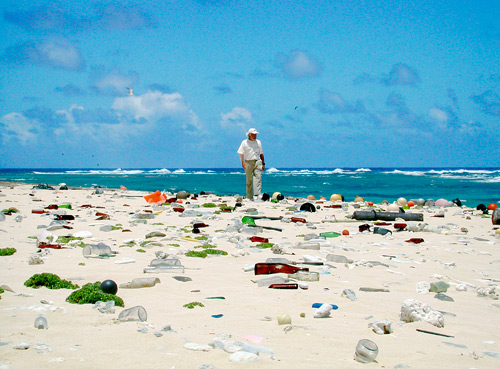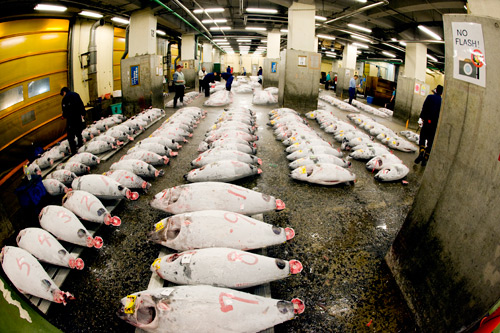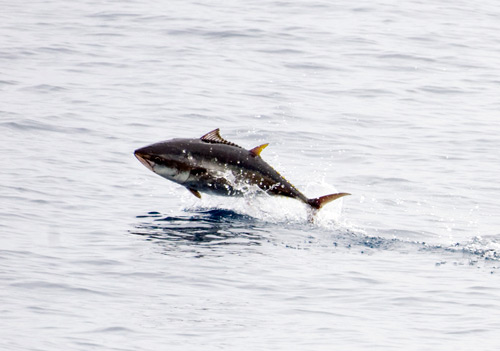State of the Ocean
By Jean-Michel Cousteau

Beginnings are always a time for renewal and optimism and the debut of 2010 is a good time to consider what we are faced with that concerns the ocean and the environment. The meetings on climate change in Copenhagen must now result in global policy change, but there are other areas specific to ocean policy that must be addressed. They are:
- Treating the ocean as a garbage dump
- Destroying coastal habitats
- Overfishing.
The truth is that even if climate change weren’t an issue, if we don’t address these trends, we will inevitably have a catastrophe.
Everything Goes Somewhere
A few years ago, I visited the Northwestern Hawaiian Islands, which sadly have become the battered and now visible victims of the ‘Out of sight, out of mind’ attitude.
The NWHI group is one of the most remote landmasses in the world and for the most part has long been untouched by human influence. But they’re subject to the flow of the North Pacific Gyre, a circular movement of water on a planetary scale that flows from west to east in the northern Pacific Ocean, down the coasts of North and Central America, and then east to west back across the Pacific and finally northward along the coast of Japan.
I have recently walked the beaches of these islands and have seen what the Pacific Gyre now delivers to their shores: hypodermic needles, computer screens, toothbrushes, children’s toys, fishing nets, cigarette lighters and countless pieces of colourful, yet unidentifiable, plastic.
The Great Pacific Garbage Patch, now a massive floating island of debris in the Pacific, is a nightmare vortex of trash extending deep into the water column and affecting every marine species that encounters it. This accumulation of misery is estimated to be twice the size of Texas.
In the central Pacific there are up to six pounds of marine litter to every pound of plankton, and roughly 46,000 pieces of litter in every square mile of the oceans, according to the United Nations Environment Program. The Pacific Ocean is filling up with trash.
Philosophically, the solution is simple: we need to legislate biodegradable packing; don’t over consume; buy only what you really need; don’t throw waste into the environment; and recycle. This is an individual and personal issue but it requires the support of governmental policy and the willingness for industrial change.
The Giant Pacific Garbage Patch is caused by each of us every day because when we throw anything away that object goes somewhere. We need to and can control where it goes and that means each of us can take some action concerning what we purchase and where we place it when its usefulness is finished.
Another of my concerns is the old belief that ‘Dilution is the solution,’ which is totally false, especially with the toxic, invisible, chemical brew entering the sea every day. In investigating the status of killer whales in the eastern Pacific, we discovered that they are contaminated with many chemicals, including PBDEs, a class of toxic flame retardants found in mattresses, couches, pillows, rugs, automobiles and electronics, and chemically similar to the banned PCBs. These chemicals become airborne, enter the water system and the food chain, and have now become a health concern for orcas and other sea life, as well as putting our own pets and children at risk.
As a society, we must shift the burden of proof to the chemical companies to verify that a product is safe before it enters the market. It is irresponsible for the government to step in only after we have proof, 30 years later, that some chemicals have already cheated our children of their future. If we demand that the correct principles be followed – that is, Safe Before It Is Sold – then we won’t be in an eternal cycle of catch-up, having to react to each new crisis. Prevention is always better than cure.

Recognizing True Value
As we discover more connections within the natural system, we are often surprised. For example, our team explored the waters of southeast Florida in the company of Goliath groupers. These gigantic fish are struggling after being decimated by fishermen who didn’t understand that when the fish are easiest to catch—in their mass spawning gatherings—is when they should be left alone.
Also, we haven’t always understood that currents carry the eggs and larvae hundreds of miles to shore, to the protective roots of the mangroves. Baby groupers spend the first seven years of their life protected by this habitat before they enter the deep waters of the sea to grow into the giants we encountered.
We had missed the critical connection of the mangroves, which were seen by some as useless obstructions to coastal development – and so destroyed. Throughout the world where mangroves have been removed there has been coastal erosion and loss of fisheries.
Now we know. We better understand that mangroves, marshlands, wetlands, swamps, and near-shore reefs not only protect the land from storm and surge, they also serve as nurseries for fish we associate with the open sea. We must have a similar appreciation for tropical coral reefs, which protect island shorelines, provide a source of food for millions of island people, and play a critical role in island economies that depend on tourism.
The solution is simple—maintain, protect and restore these critical habitats and realize their true value. We have sacrificed too much for seaside condominiums that are now in foreclosure. We cannot afford to risk foreclosure on our sea life.
The Easiest Solution
Ninety percent of all large fish populations are at risk from overfishing and most commercial fisheries are in decline. The problem is enormous but the solution is clear, quickly effective, and costs little.
The most direct solution to overfishing is the creation of Marine Protected Areas or MPAs, a prescribed part of the ocean that is off limits to fishing or any activities that would disturb the natural functioning of that area. This is not a new idea. I learned years ago while in Fiji that when a high chief died, a section of reef was set aside from fishing for a few months or years as an act of respect to the local chief. The villages then could have a great feast to honor the dead chief with a predictable supply of fish and shellfish.
In the United States, the first marine protected area had nothing to do with fish or the ocean; it was part of the space program off Cape Canaveral. A large portion of the sea and coastline near the launching pad of the U.S. space program was declared off limits to all fishing and boating to secure the area for missile launches. Years later, it was noticed that at the perimeter of the area, there was a crowd of fishing boats because the fish were so abundant.
The phenomenon is simple: with no fishing pressure, populations were able to rebound and repopulate the protected area. The abundance was so great that fish began to spill over outside the area and create a profitable fishing ground. Scientists stepped in to study the effect of total protection and discovered that, in specific areas in as short a time as three years, some fish populations are able to repopulate and begin to spill over.
With only 0.8 of one percent of the global ocean under protection, we must step up the pace toward more MPAs. But there is another shift that needs to take place.

The Inland Sea
We are on a collision course: world population is increasing and so is the demand for seafood as climate change threatens the fragile food web and at a time when we have reached a possible tipping point of overfishing in all the world’s major fisheries. So when we need it most, the once abundant supply of seafood is vanishing.
In part, the solution lies in duplicating the success we have already had on land. At a crucial point in ancient civilizations, we moved from hunter/gatherers to farmers. We need to do the same with seafood. We need to make the technological leap to farm herbivorous fish without the ocean; in other words, we need aquaculture on land, far from where we may do any harm to the sea and natural populations of sea life.
The hope for the future lies in self-contained fish farms dotted across the landscape, serving metropolitan areas, creating supply where demand exists, in Berlin, Topeka, Paris, Madrid, Beijing, Johannesburg, Lima. My vision is of a thriving seafood industry located near metropolitan areas and supplying homes and restaurants with seafood fresh from the farm, providing a healthy product with minimal transportation.
The opportunity is enormous: the U.S. imports over 84 percent of its seafood. U.S. aquaculture provides only five to seven percent of the demand for seafood and that is mostly in the form of catfish. There is an opportunity to create a vastly successful industry to meet an exploding demand and to do it in a way that protects the environment and sustains the seas.
A Global Shift
In today’s marketplace, no business can ignore its environmental footprint because its customers now want to know what that business is doing to minimize waste, minimize use of resources, and create products that are not harmful to the environment. We are beginning to experience a wave of sustainable prosperity and it is a wave capable of reaching all shores.
The Northwestern Hawaiian Islands are a symbol of a new direction. At a special screening of our film, Voyage to Kure in 2006, then President Bush was moved by the beauty of this marine paradise and shocked by the trash piled up on the shore. He immediately acted to create what was then the largest marine protected area in the world, like the MPAs spreading around the globe. These areas become our partnership with nature where we uphold our side, which is basically to do no harm. We know the harm we have done to the ocean, and now we must act with greater commitment and knowledge and speed. It is time.







